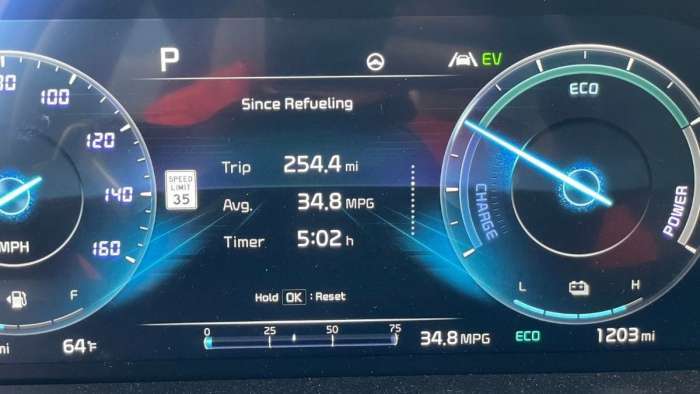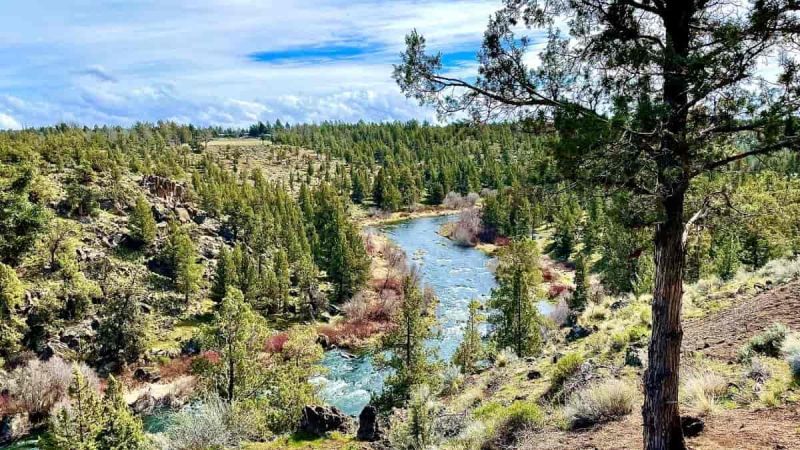One thing becomes immediately clear to me as we hit the open interstate: my wife’s predilection for putting her foot down makes a big difference (in our fuel efficiency). To be fair, she is only going a few miles an hour over the speed limit, which is now 70 mph, and is using the active cruise control. There are several rolling hills along the Cowlitz River on this stretch of I-5 south, which means the cruise control will potentially push our KIA Sorento PHEV harder to precisely keep up its speed.
I would bet a pint of porter that a driver could get a little better fuel efficiency by manually manipulating the accelerator in such conditions. I suspect that if she slowed to the speed limit and didn’t use the cruise control except on long flat or downhill stretches, her average mpg would improve from a little less than 27 mpg to perhaps the low 30’s. I’ll actually test this out later, but I don’t tell her this because I don’t like ticking her off. I stare at the budding maple trees and gently waving pines crowding the roadside and think about what matters: having a good time! This is something of an experiment after all, to see how our new vehicle performs in various conditions and via the application of different techniques. You do you honey.
We’ve got a two and a half hour drive to meet our friends at The Pines 1852 tasting room in downtown Hood River. It’s freeway the whole way, but the section along the Columbia River is particularly gorgeous. Waterfalls, intricately carved cliff faces, small towns clinging to their faces and embracing their bases line the mighty Columbia River Gorge and the region is full of excellent scenic hikes. It’s a place one could spend weeks exploring. But I have chosen this particular winery because their vineyards happen to have the oldest Zinfandel vines in the Pacific Northwest, planted in the 1880’s.
Zinfandel is a grape more commonly associated with the vineyards of northern central California and parts of Croatia. It is the grape countless tons of jug wines are made from, the wine my parents drank when I was a kid and is still a favorite of my father and uncle who grew up in the vicinity of Lodi, California (the virtual center of American Zinfandel production). It is also what goes into “White Zinfandel”, a wine that graces the isles of so many grocery stores across the country. Pro tip: there is no such thing as a White Zinfandel grape, there are only red Zinfandel grapes (the color of the grape isn’t even part of its name, officially). White Zinfandel is a rosé version of Zinfandel that is simply picked and processed differently than the red version, which means it has much less contact time with the red grape skins after being crushed. We are not interested in the rosé version though; we are wine enthusiasts and we may make many pour decisions, but this will not be one of them! We’re here for the deeply red hued, spicey, tobacco and fig flavored goodness of a hearty Zin. The tasting room, along with the rest of downtown Hood River, is on a hill overlooking the river. The old brick and mortar walls, the varnished hardwood bar, and high back velour chairs, give the place a nice vintage charm. The Pines 1852 wines are hearty, flavorful and well structured. I’ll save the rest of the details for a different forum, but suffice it to say, this place is worth the stop if you’re a red wine lover and happen to be exploring the area.
Back to the car stuff; after we got back on the road and drove another 20 miles to the last town of any size before reaching our destination, we stopped to gas up in The Dalles. After 254.4 miles, with one full recharge in Olympia, our mpg was a combined 34.8. My wife drove us from Olympia to Hood River, and got about 29 mpg (remember, she’s got a little heavier foot and used the cruise control most of the way). About ⅔ of that distance she was driving about 73 mph, and the last third, through Portland and to Hood River, about 67 mph (the speed limit was mostly 65 through the Portland area and along the Columbia River). I drove the last 20 miles from Hood River to The Dalles and got 37.2 mpg. I was driving the speed limit or 1-2 miles below. Not that it should surprise anyone, but driving faster gets you worse fuel efficiency. It’s just science folks.

From The Dales to our destination outside Bend, Oregon (another 120 miles), we drive through the foothills of the Cascades, up and down numerous steep hills and winding canyon roads through a couple tiny riverside towns and mostly empty pasture land. It is beautiful, and stoic. Due to all the hills, our fuel economy suffers a bit, though the slower speeds (55 mph for much of it) helps balance that out. I still managed to get 34.5 mpg, using gas most of the way (we used up the last of the battery charge the last 20 miles of the trip), which is slightly better than the EPA rated mpg for our KIA Sorento PHEV.
Once on site, we have access to a single J-1772 240V charger (we’re staying at a resort that can accommodate a few thousand people, so there’s several EV and PHEV drivers that are interested in accessing the charging station). During check-in it is open so I park for the ten minutes or so it takes us to get checked in. Surprisingly, that gives us about 4 miles of range, and I chalk that up to a warm, depleted battery being able to take about 3.7 kW of charge during that short period of time. I believe the usual rate of charge is closer to 3.3 kW and I’ve noticed that the closer the battery is to fully charged the slower each percent goes by. I came back later that evening to see a Tesla charging up (which of course doesn't have a gas engine back-up like I do), and again in the morning (13 hours later) it’s still there. I count two Teslas, a Hyundai Kona EV and a Chevy Volt all parked in the vicinity.
Clearly, there is strong demand for the limited charging infrastructure available here and it makes me wonder: in a few more years, when the number of plug-in vehicles on the roads will be significantly higher, will it be untenable to drive an EV here (having to wait potentially a couple of days to get a spot)? This makes me glad I have both an EV and a PHEV for now and can choose which to drive. It also makes me want to reach out to the management of the resort to ask if they might have plans to expand charging options in the future (putting in 110v outlets near the condo units, which already have electrical run to the parking areas, for example). Like the Boyscouts say: always be prepared!
Justin Hart has owned and driven electric vehicles for over 14 years, including a first generation Nissan LEAF, second generation Chevy Volt, Tesla Model 3, an electric bicycle and most recently a Kia Sorento PHEV. He is also an avid SUP rider, poet, photographer and wine lover. He enjoys taking long EV and PHEV road trips to beautiful and serene places with the people he loves. Follow Justin on Twitter for daily KIA EV news coverage.













Comments
like this article!
Permalink
like this article!
Utilizing photography, evoking the reader's senses by pairing data and performance with intimate glimpses of the environment brings the reader into real time engagement, presence.